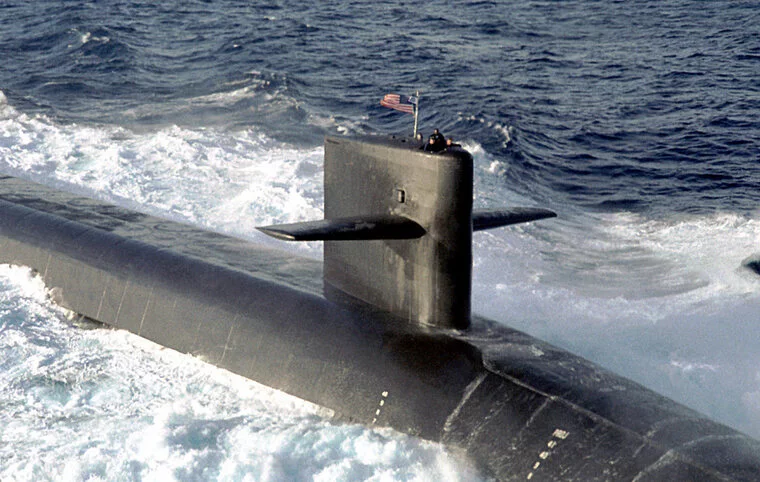A recent Chinese study asserts that it has discovered an innovative technique for potentially shaking the foundations of America’s long-standing dominance in submarine warfare.
Published in the Chinese Journal of Ship Research, the research suggests that even the United States advanced nuclear submarines could be tracked using a novel method for detecting the faint bubbles a vessel generates as it navigates underwater.
In recent years, the United States and China have been fierce competitors in a technological arms race, from artificial intelligence to hypersonic weapons or space exploration.
And while there are mounting concerns that the U.S. is falling behind in advancing critical future-oriented technologies, America’s military has continued to maintain an edge over Beijing, particularly in submarine warfare capabilities.
The U.S. Navy’s fleet currently includes over 70 submersible warships, most outfitted with cutting-edge acoustic and vibration-reduction systems, rendering them nearly indistinguishable from the ocean’s ambient noise.
“U.S. defense strategy depends in large part on America’s advantage in undersea warfare,” Bryan Clark, a Senior Fellow at the Center for Strategic and Budgetary Assessments, wrote in a 2015 report on The Emerging Era in Undersea Warfare. “Quiet submarines are one of the U.S. military’s most viable means of gathering intelligence and projecting power in the face of mounting anti-access/area-denial (A2/AD) threats being fielded by a growing number of countries.”
In the report, Clark warns that America maintaining underwater supremacy is not a foregone conclusion, saying that “U.S. submarines are the world’s quietest, but new detection techniques are emerging that do not rely on the noise a submarine makes, and that may render traditional manned submarine operations far riskier in the future.”
Recent research by the Chinese Academy of Sciences’ Fujian Institute of Research on the Structure of Matter suggests that this more perilous era for manned submarine operations is now upon us.
According to the paper, an ultra-sensitive magnetic detector could pick up the minuscule bubbles produced by underwater vessels, including even the stealthiest American subs.
As a submarine moves at high speeds, water flows around its hull, causing near-imperceptible bubbles to form due to changes in pressure and kinetic energy. This process, known as cavitation, generates electromagnetic signatures due to the magnetohydrodynamic (MHD) effect. The faster the water flows, the stronger the signature becomes.
Researchers used a computer simulation to determine if these near-undetectable bubbles could be picked up by advanced sensors, thus resulting in a novel method for tracking stealth nuclear-powered submarines.
Results showed that the extremely low frequency (ELF) signals produced by cavitation could be acquired using existing magnetic anomaly detectors.
“Significant induced electric field signals can be observed around the bow, stern, and rear of the hull,” researchers wrote. “[Therefore] the induced electromagnetic characteristics of submarines can be employed to guide the non-acoustic detection of underwater moving bodies.”
Researchers said that although the electromagnetic signals produced by cavitation are faint, they can still be detected over great distances due to the signals’ ability to penetrate water and be reflected back to the Earth’s surface by the ionosphere.
Study authors note several potential challenges to using ELF signals to track a submarine, especially one intentionally trying to remain hidden. For instance, the ELF signal produced by cavitation will disappear when a sub slows down, and there’s the risk of interference from naturally occurring electromagnetic noise or electronic countermeasures.
The research team, which was led by physicist and researcher at the Chinese Academy of Sciences, Dr. Zou Shengnan, recommended further research to better understand the complex interplay between fluid dynamics and electromagnetic signals, acknowledging that findings were only the beginning of what could be a fundamental shift in naval warfare and communication technologies.
Beyond its military implications, the study also touches on potential advancements in electromagnetic communication technologies for high-speed submarines.
Ultimately, this recent revelation of a potential new method to detect U.S. submarines comes during heightened geopolitical tensions and technological rivalry between the United States and China.
While American naval superiority, particularly in stealth submarines, has been an anchor of its defense strategy for decades, these findings hint that resting on past achievements may be a risky proposition.
“Emerging technologies present a serious challenge in that they may empower the development of potent rival undersea forces and erode the stealth of U.S. submarines,” notes Clark in The Emerging Era in Undersea Warfare.
“But they also provide the United States an opportunity to again be the ‘first mover’ and establish a dominant position in the next chapter of the undersea competition.”
Tim McMillan is a retired law enforcement executive, investigative reporter and co-founder of The Debrief. His writing typically focuses on defense, national security, the Intelligence Community and topics related to psychology. You can follow Tim on Twitter: @LtTimMcMillan. Tim can be reached by email: tim@thedebrief.org or through encrypted email: LtTimMcMillan@protonmail.com

